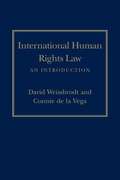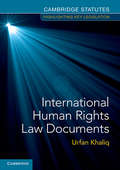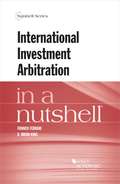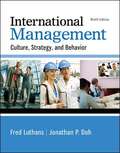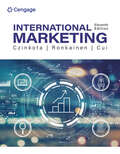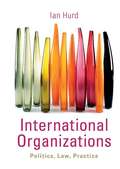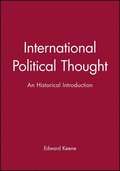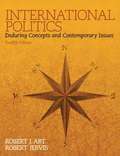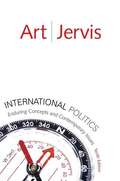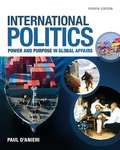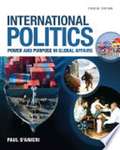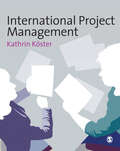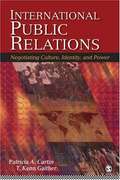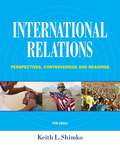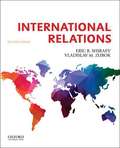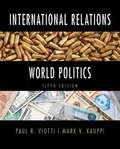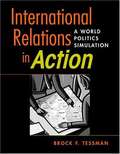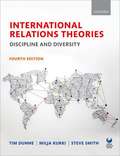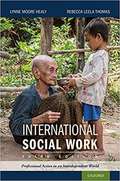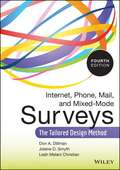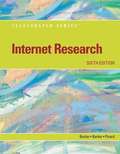- Table View
- List View
International Human Rights Law: An Introduction
by David Weissbrodt Constance de la Vega"International Human Rights Law" is a comprehensive introductory treatise, intended for all concerned about this critical area of international law, including students, lawyers, other advocates, teachers, and academics.
International Human Rights Law and Practice
by Ilias Bantekas Lutz OetteHuman rights law is a complex but compelling subject that fascinates students but also confuses them. This innovative textbook explores human rights law from a theoretical and practical perspective. Case studies and interviews with specialist practitioners, NGO activists and policy-makers show how theory is applied in real life. The up-to-date coverage includes introductions to important emerging fields such as globalisation, poverty and advocacy. Student learning is supported by questions to stimulate seminar discussion and further reading sections that encourage independent study. The authors' combined expertise, engaging writing style and ability to clarify not simplify ensures that this important new book will become required reading for all students of human rights law.
International Human Rights Law Documents
by Urfan KhaliqThis accessible collection of important international human rights documents is an essential resource for students and researchers of international human rights law. In addition to standard instruments such as the Universal Declaration, the 1966 United Nations Covenants and the European Convention and its Protocols, the volume also features topics and documents such as all core UN human rights treaties and their protocols, key international labour instruments and the obligations of the global financial organisations and multi-national corporations. Taking a broad and historical approach, the collection also incorporates Inter-American, African, Asian and Arab instruments alongside older UN documents and numerous soft law documents. Its approach reflects the diverse nature of international human rights law and the courses which now seek to teach it. This book is also valuable for students of international law, global governance and other courses which discuss the law of international human rights.
International Investment Arbitration In A Nutshell (Nutshells)
by Franco Ferrari D. Brian King Domenico Di Pietro C. Ryan Reetz Friedrich Rosenfeld Monique SassonForeign direct investment ("FDI") is a key pillar of the world's global economy. International investment law comprises the rules regarding the protection of investors engaging in FDI activities. This book summarizes the current legal regime of international investment protection and the challenges that lie ahead of it. Its ambition is to provide a concise introduction to the key substantive and procedural standards of international investment protection.
International Law: Cases and Materials (6th Edition)
by Lori F. Damrosch Sean D. MurphyThis classic international law casebook has been updated to cover recent case law, including the International Court s Extradite or Prosecute (Belgium v. Senegal) case, and the Supreme Court s decisions in Samantar v. Yousef (on foreign sovereign immunity) and Kiobel v. Royal Dutch Petroleum (on the Alien Tort Statute). With extraordinary range and depth, this casebook probes "hot topics" such as the Syrian civil war, the seizure of pirates, and the ICC's indictments of African leaders, all calculated to provoke engaging classroom discussions. This casebook is designed for introductory and advanced classes, with detailed readings on the structure and actors of international law and on specialized areas.
International Management: Culture, Strategy, and Behavior (Ninth Edition)
by Fred Luthans Jonathan P. DohInternational Management: Culture, Strategy, and Behavior reflects new and emerging developments influencing international managers. With integrated real-world examples, research, and practical applications, students understand how to adjust, adapt, and navigate the changing global business landscape and respond to global challenges - making it a market - leader. The authors retain research and practices over the past decades, and incorporate new and emerging developments affecting international managers to increase students' effectiveness in managing across cultures.
International Marketing
by Philip R. Cateora R. Bruce Money Mary C. Gilly John L. GrahamInternational Marketing addresses global issues and describes concepts relevant to all international marketers, regardless of the extent of their international involvement. The text will stimulate curiosity about management practices of companies, large and small, seeking market opportunities outside the home country and to raise the reader's consciousness about the importance of viewing international marketing management strategies from a global perspective. Although this revised edition is infused throughout with a global orientation, export marketing and the operations of smaller companies also are included. Issues specific to exporting are discussed where strategies applicable to exporting arise, and examples of marketing practices of smaller companies are examined.
International Marketing: What Executives Need To Know
by Michael R. Czinkota Ilkka A. Ronkainen Annie Peng CuiExamine today's best practices and key issues impacting international marketing with the best-selling, upper-level international marketing text — Czinkota/Ronkainen/Cui's INTERNATIONAL MARKETING, 11E. <p><p>This innovative resource offers cutting-edge international marketing strategies and guidelines using the latest examples. You explore the range of international marketing topics, from start-up operations and new market entry considerations to key international issues confronting today's giant global marketers. Updates address international e-commerce and technology as well as the impact of culture and government on marketing throughout the world. Case studies highlight the latest marketing practices in real organizations, while Internet exercises focus on online opportunities. <p><p>This in-depth coverage prepares you for success in today's international business world, whether you are an upcoming international marketer or practicing executive.
International Organizations: Politics, Law, Practice
by Ian HurdThis textbook examines the world's most important international organizations, comparing their political environments, legal powers, and controversies. It examines 10 international organizations in detail: what they do, how and why they do it, and the problems they face.
International Political Thought: A Historical Introduction
by Edward KeeneThis volume offers an accessible and wide-ranging introduction to the history of international political thought. Taking as its starting-point the various concepts people have used to think about differences between political communities, the book explores changing perceptions of international politics from antiquity to the twentieth century. As well as discussing well-known themes such as relations between independent sovereign states and the tension between raison d'etat and a universal code of natural law, it also examines less familiar ideas which have influenced the development of international political thought such as the distinction between civilization, national culture and barbarism, religious attitudes towards infidels, and theories about racial difference and imperialism. Among the key thinkers covered are Thucydides, Machiavelli, Hobbes, Kant, Marx and Morgenthau, alongside less commonly studied figures such as Herodotus, Pope Innocent IV, Herder, Constant and Zimmern. Each chapter concludes with a guide to further reading which will help students to develop a more detailed understanding of the subject. Written with the beginner student in mind, this lively textbook is an ideal introduction for anyone studying international political thought.
International Politics: Enduring Concepts and Contemporary Issues Twelfth Edition
by Robert J. Art Robert JervisChallenging students to use original scholarship to recognize and analyze patterns in world politics, this bestselling reader considers how to effectively understand politics under governments and beyond. Carefully edited selections cover the most essential topics and are put into conversation with each other to illustrate fundamental debates and differing points of view. Comprehensive and engaging, International Politics offers the best overview of the discipline as well as the forces shaping the world today.
International Politics: Enduring Concepts And Contemporary Issues, 10th Edition
by Robert J. Art Robert JervisFifty papers by scholars of economics, international relations, and related fields discuss the anarchic structure of international relations, the use of force, the international political economy, and contemporary world politics. Current issues like international cooperation, nuclear proliferation, globalization, terrorism, failed states, and climate change receive special attention.
International Politics: Power And Purpose In Global Affairs (Fourth Edition)
by Paul D'AnieriINTERNATIONAL POLITICS: POWER AND PURPOSE IN GLOBAL AFFAIRS, 4th Edition, helps you make the connection between analytical theories and real-world issues and events. The focus on power and purpose engages both the goals that actors have in international politics, and the ways they have to achieve them. Thought-provoking case studies and features on history, policy, and geography let you see the world from multiple perspectives, while critical-thinking questions for each feature ask you to examine what you have learned. The Connection to You boxes show how international politics directly affects the lives of individuals, and how individuals can influence international politics.
International Politics: Power And Purpose In Global Affairs
by Paul D'AnieriD'Anieri's INTERNATIONAL POLITICS: POWER AND PURPOSE IN GLOBAL AFFAIRS, 5th Edition, helps you make the connection between academic theories and real-world issues and events. Comparing international politics to a series of intellectual puzzles, the text emphasizes the importance of examining problems from multiple perspectives. Its unique focus on power and purpose involves both the goals that players have in international politics and the ways they have to achieve them. Detailed, up-to-date discussions cover populism and trade wars, critical international relations theory, international hierarchy, the impact of social media and bias, Brexit, U.S.-China trade conflict and much more. Thought-provoking case studies and features on history, policy and geography let you see the world from numerous perspectives while sharpening your critical thinking skills. Also available: MindTap.
International Project Management
by Kathrin KosterWith project management becoming an increasingly global endeavour, a comprehensive and international student text that reflects this reality is essential.<P> International Project Management does just that, systematically linking the key elements of cross-cultural management and the particularities of an international context, with the tools and techniques of project management.<P> Key features include:<P> - A wide variety of examples and illustrations, including an in-depth, end-of-chapter case study with case questions;<P> - Student exercises and review questions;<P> - Detailed further reading<P> - The full support of a Companion Website, featuring a Teacher's Manual<P> Visit the Companion Website at www.sagepub.co.uk/koster
International Public Relations: Negotiating Culture, Identity, and Power
by Patricia A. Curtin T. Kenn GaitherInternational Public Relations: Negotiating Culture, Identity, and Power offers the first critical-cultural approach to international public relations theory and practice. Authors Patricia A. Curtin and T. Kenn Gaither introduce students to a cultural-economic model and accompanying practice matrix that explain public relations techniques and practices in a variety of regulatory, political, and cultural climates. offers the first critical-cultural approach to international public relations theory and practice. Authors Patricia A. Curtin and T. Kenn Gaither introduce students to a cultural-economic model and accompanying practice matrix that explain public relations techniques and practices in a variety of regulatory, political, and cultural climates.
International Relations: Perspectives, Controversies and Readings (Fifth Edition)
by Keith L. ShimkoEngaging and highly accessible, this reader-friendly text features broad coverage of key principles of international relations, providing a thorough introduction to the discipline while avoiding excessive detail and complexity. International Relations: Perspectives, Controversies, and Readings, Fifth Edition, explores essential concepts such as power politics, war and democracy, human nature, free trade, inequality, globalization, humanitarian intervention, and terrorism. Each chapter features brief, topical coverage presented within a debate framework, challenging you to think critically, consider diverse perspectives, and apply what you have learned to real-world scenarios. The author also includes current, relevant primary source readings, giving you firsthand exposure to the materials and ideas shaping international relations today. Thoroughly revised, the Fifth Edition of this popular text features updated content in nearly every chapter, including the most recent statistics, research, trends, theories, and examples drawn from today's headlines, including chemical weapons in Syria, the conflict between Russia and Ukraine, and the debate over climate change and global resources.
International Relations
by Eric B. Shiraev Vladislav M. ZubokUsing a three-part framework of Ideas, Arguments, and Contexts and Applications, International Relations, Second Edition, shows students how to think critically about issues and current events in world politics. Each chapter first describes key concepts and developments in the field (Ideas), then presents the main theoretical and analytical approaches (Arguments), and finally applies the main theories and approaches within the individual, state, and global contexts (Contexts and Applications). Historical information is woven throughout the text, and every chapter ends with an extended case study ("The Uses of History") that demonstrates how what we have learned from the past can influence our future actions. Three full chapters on key approaches--realism (chapter 2), liberalism (chapter 3), and constructivism and other alternative views (chapter 4)--introduce students to a broad spectrum of approaches, and each chapter integrates discussions of relevant theories and levels of analysis. Visual Reviews at the end of each chapter not only recap key points but include Critical Thinking questions that reflect the chapter learning objectives.
International Relations and World Politics
by Paul R. Viotti Mark V. KauppiUpdated in its 5th edition, International Relations and World Politics is a toolkit that offers an authoritative survey of the field and practical ways to analyze current and future world problems. Drawn from the authors’ experience as scholars and practitioners, this new edition was completely rewritten to focus on an enduring teaching and learning goal–how individuals can apply theory, history, geography, and more for a lifetime of understanding politics in a globalized world. Whether as actors themselves in world politics, participants in the global economy, or simply readers of world news, those reading International Relations and World Politics not only get more help to master the field’s concepts but also get more help to understand that these are real-world ideas with real-world implications.
International Relations in Action: A World Politics Simulation
by Brock TessmanThis hands-on exercise allows students to relate the concepts and issues at the foundation of global politics to the realities of international politics today. As influential leaders in the fictional world of Politica, each team of students governs a country with a unique history, geography, and culture. The teams must use strategy and negotiation to succeed - and survive - seeking to achieve specific territorial, security, and economic objectives. In the process, they grapple with a range of complex challenges: energy security, ethnic conflict, humanitarian intervention, environmental disaster, terrorism, nuclear proliferation, and more. Students also pursue individual objectives based on the governmental post they hold - and quickly learn that self-interest and national interest are not always compatible. Teams are judged on their effectiveness in meeting stated objectives, but must also relate their practical experience to the academic content of the course. Toward this end, the book provides summaries, analysis, study questions, and additional sources of information for each of the theories and issues encountered during the simulation. Guidelines for instructors are also included. "International Relations in Action" has been tested in multiple courses, with students and instructors unanimously agreeing that it makes abstract theories practical and accessible, evokes an appreciation for the complexity of international politics, and generates enthusiasm for the study of international relations. In the representative words of one student, "It was the best learning experience I've ever had."
International Relations Theories: Discipline and Diversity (Fourth Edition)
by Tim Dunne Milja Kurki Steve SmithBringing together the most influential scholars in the field, International Relations Theories: Discipline and Diversity provides unrivalled coverage of international relations theories and arguments. This best-selling text explores the full spectrum of theoretical perspectives and debates, ranging from the historically dominant traditions of realism, liberalism, and Marxism to postcolonialism and green theory. Each chapter is dedicated to a particular theory and features a case study that bridges theory and practice, showing how theory can be used to explain real world political dilemmas. Spotlights on key books and articles encourage readers to go beyond the textbook and explore important works in the field, and new case study questions encourage analytical thinking and help readers understand the value of applying theory to concrete political problems.
International Social Work: Professional Action In An Interdependent World
by Lynne Moore Healy Rebecca Leela ThomasInternational Social Work: Professional Action in an Interdependent World, Third Edition, is a comprehensive treatment of all dimensions of international social work. The authors' four-part framework includes domestic practice and policy influenced by global forces, professional exchange, international practice, and global social policy. The first section of the book explores globalization, development and human rights as foundational concepts for international social work. The text then provides an overview of global social issues and international organizations related to social welfare. Part II offers an overview of the global history of the profession. Similarities and differences in social work around the world are examined through seven country examples. Part III provides an extensive discussion of current aspects of the global profession, with chapters on ethics, social policy, international development practice, and practice at the international/domestic interface. Modalities of international professional exchange are then explored prior to a concluding chapter that provides recommendations for international action. The text is enlivened by numerous case examples, drawn from many parts of the world. The history chapters include brief biographies of noted social workers on the international scene whose accomplishments serve as inspiration for readers. The text is extensively referenced with updated professional literature and intergovernmental documents. Carefully selected items in the appendix expand the usefulness of the book.
International Trade: Theory and Policy
by Steve SuranovicInternational Trade: Theory and Policy is built on Steve Suranovic's belief that to understand the international economy, students need to learn how economic models are applied to real world problems. It is true what they say, that "economists do it with models." That's because economic models provide insights about the world that are simply not obtainable solely by discussion of the issues. International Trade: Theory and Policy presents a variety of international trade models including the Ricardian model, the Heckscher-Ohlin model, and the monopolistic competition model. It includes trade policy analysis in both perfectly competitive and imperfectly competitive markets. The text also addresses current issues such as free trade area formation and administered protection policies. The models are developed, not by employing advanced mathematics, but rather by walking students through a detailed description of how a model's assumptions influence its conclusions. But more importantly, each model and theory is connected to real world policy issues. The main purpose of the text is to provide a thorough grounding in the arguments concerning the age-old debate about free trade versus protectionism.
Internet, Phone, Mail, and Mixed-Mode Surveys: The Tailored Design Method (Fourth Edition)
by Don A. Dillman Leah Melani Christian Jolene D. SmythThe classic survey design reference, updated for the digital age For over two decades, Dillman's classic text on survey design has aided both students and professionals in effectively planning and conducting mail, telephone, and, more recently, Internet surveys. The new edition is thoroughly updated and revised, and covers all aspects of survey research. It features expanded coverage of mobile phones, tablets, and the use of do-it-yourself surveys, and Dillman's unique Tailored Design Method is also thoroughly explained. This invaluable resource is crucial for any researcher seeking to increase response rates and obtain high-quality feedback from survey questions. Consistent with current emphasis on the visual and aural, the new edition is complemented by copious examples within the text and accompanying website. This heavily revised Fourth Edition includes: Strategies and tactics for determining the needs of a given survey, how to design it, and how to effectively administer it How and when to use mail, telephone, and Internet surveys to maximum advantage Proven techniques to increase response rates Guidance on how to obtain high-quality feedback from mail,electronic, and other self-administered surveys Direction on how to construct effective questionnaires,including considerations of layout The effects of sponsorship on the response rates of surveys Use of capabilities provided by newly mass-used media:interactivity, presentation of aural and visual stimuli. The Fourth Edition reintroduces the telephone-including coordinating land and mobile. Grounded in the best research, the book offers practical how-to guidelines and detailed examples for practitioners and students alike.
Internet Research (Sixth Edition)
by Katherine Pinard Donald Barker Melissa BarkerThis book is an ideal learning tool for a wide range of learners. It provides essential information about Internet research, including topics on search toolbars, intelligent search agents, and finding, evaluating and citing online sources.
